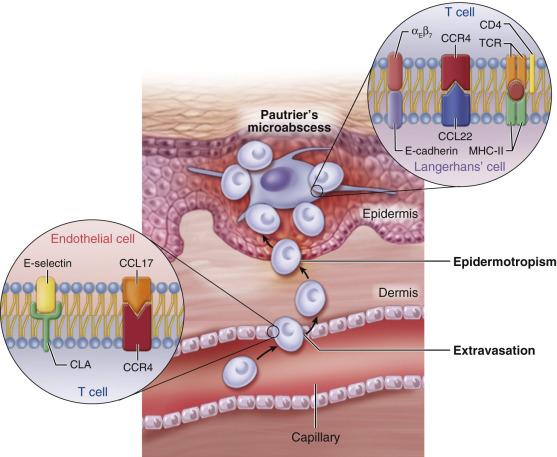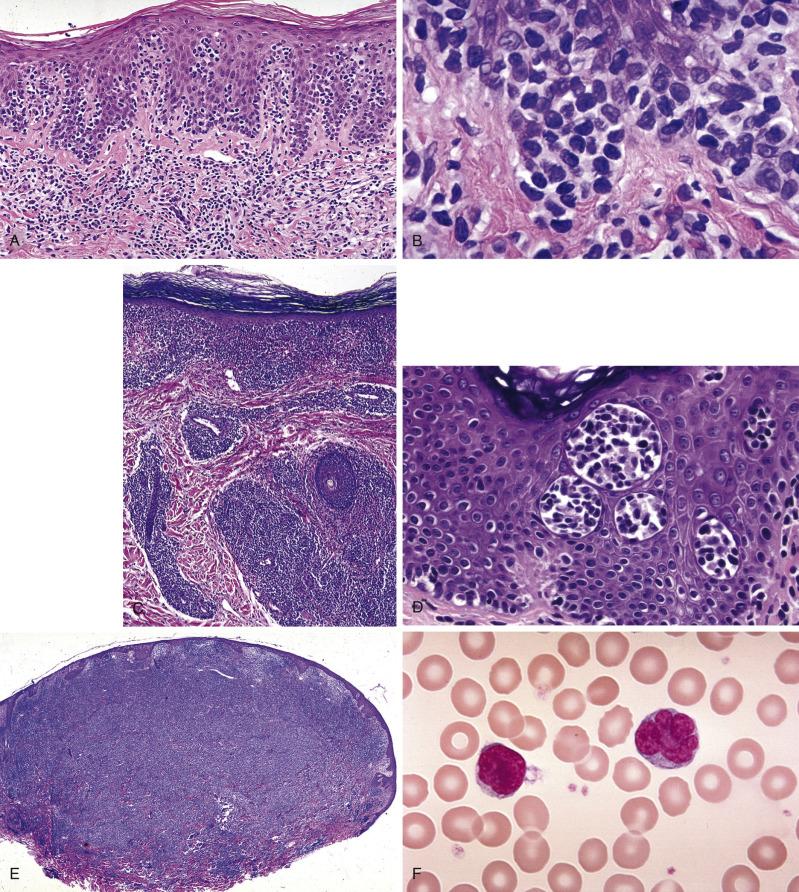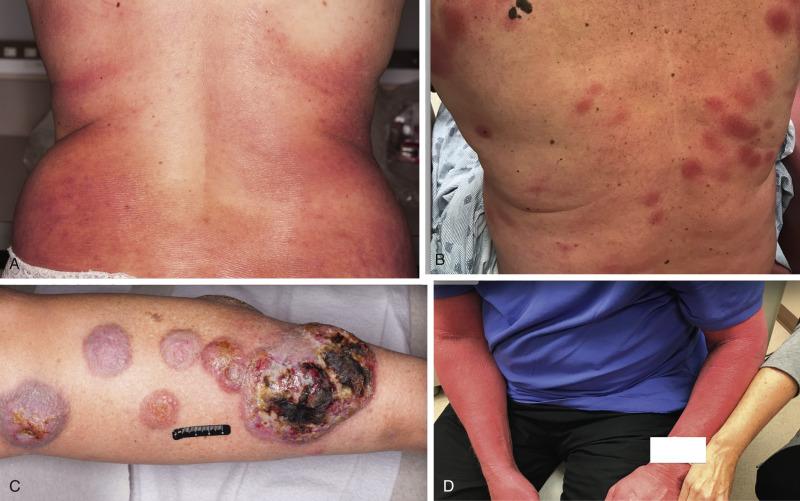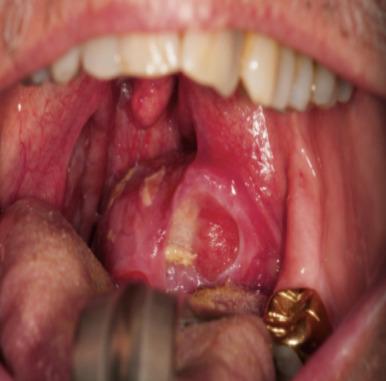Physical Address
304 North Cardinal St.
Dorchester Center, MA 02124
The age-adjusted incidence of mycosis fungoides (MF) is approximately 6.4 cases per million. Three thousand cases per year are diagnosed in the United States, representing 72% of cutaneous T-cell lymphomas.
Mycosis fungoides is a chronic malignant disease of the skin involving skin-homing CD4+ T cells. The classical immunophenotype is CD2 + CD3 + CD4 + CD5 + CD45RO + CLA + (cutaneous lymphoid antigen) CD8 − CD30 − . Early disease is characterized by patches and plaques affecting the skin, with or without nodal or blood involvement. Advanced disease is characterized by cutaneous tumors, erythroderma, or lost epidermotropism and visceral involvement.
TNMB staging is based on the percentage of cutaneous involvement, nature of the lesions, nodal, visceral, and blood involvement. History taking and a physical examination are needed to stage the disease. Skin biopsy with immunophenotyping and polymerase chain reaction are performed to determine the T-cell receptor gene rearrangement. A complete blood count with manual differential, serum chemistries, liver function tests, and lactate dehydrogenase should be performed. For stages IB to IV disease, peripheral blood flow cytometry, and peripheral blood T-cell receptor gene rearrangement should be assessed. A chest radiograph should be obtained for all patients. Computed tomography scanning should be done and positron emission tomography-computed tomography considered for stages IB to IV disease. Suspicious lymph nodes require excisional or core biopsy.
For early-stage disease, therapy is focused on sequential skin-directed therapies to simultaneously balance the objectives of achieving an optimally durable response but minimizing toxicity. Therapeutic options include irradiation, corticosteroids, psoralen plus ultraviolet A, narrow band ultraviolet B, mechlorethamine, carmustine, and topical bexarotene. Total skin electron beam therapy (TSEBT) monotherapy produces a 10-year relapse-free survival rate of approximately 50% for IA disease. TSEBT provides rapid and effective palliation, with complete response rates of 95% for T1, 90% for T2, 60% for T3, and 75% for T4 disease. Total dose for TSEBT varies widely, with a growing emphasis on lower doses and repeat courses of TSEBT. TSEBT is also often followed by adjuvant maintenance therapy. However, skin-directed therapies are not anticipated to be curative over long-term follow-up, with the natural history of disease expected to be chronic and relapsing. For progressive or refractory disease, systemic therapies include interferon-α, retinoids, bexarotene, extracorporeal photochemotherapy, denileukin diftitox, vorinostat, nucleoside analogs, and cytotoxic chemotherapy. Biological response modifiers are being currently evaluated.
TSEBT is effective therapy for achieving durable control for most cutaneous lesions. Other skin-directed therapies are also applied for patients with locally advanced disease. Traditional multiagent systemic chemotherapy does not enhance survival times but may produce palliation. Allogeneic bone marrow transplant is a promising approach for young patients with a good performance status and is considered a curative option.
Most patients require long-term therapy to relieve cutaneous symptoms. All of the skin-directed therapies produce substantial palliation. Additionally, novel biologic agents such as bexarotene, denileukin diftitox, and vorinostat (or other emerging histone deacetylase inhibitors) have efficacy in disease refractory to standard treatments.
Mycosis fungoides (MF) is a low-grade, non-Hodgkin lymphoma caused by skin-homing CD4 + T cells that form cutaneous patches, plaques, and tumors. MF was initially described in 1806 when Alibert described a patient with cutaneous tumors that he attributed to yaws. Although initially termed pian fungoides , he later changed the name to mycosis fungoides. In 1938, Sézary and Bouvrain described a leukemic variant called the Sézary syndrome (SS), and Lutzner and Jordan elucidated the ultrastructure of the Sézary cell in 1968. The term cutaneous T-cell lymphoma was introduced by Edelson in 1975 and encompasses a variety of cutaneous lymphoproliferative disorders including MF/SS, adult T-cell leukemia/lymphoma, primary cutaneous CD30 + anaplastic lymphoma, lymphomatoid papulosis, pagetoid reticulosis, and others. In clinical practice, the terms MF and CTCL are often used interchangeably; however, such usage is incorrect. MF constitutes the majority of all cutaneous T-cell lymphomas (CTCLs), and the clinical history and therapy for each subtype of CTCL are different.
MF is a challenging disorder from all perspectives. Despite improving molecular techniques, diagnosis early in the course of disease is often difficult because of the nonspecific nature of skin lesions and the numerous benign dermatoses that may mimic MF. Once a diagnosis of MF has been correctly established, the optimal initial treatment strategy often remains unclear, given heterogeneity of clinical presentations and limited data from controlled studies. Although radiotherapy is the most effective single agent in the treatment of MF, total skin electron beam therapy (TSEBT) is not readily available at many centers. This chapter provides a summary of the clinically relevant aspects of MF and describes the role and techniques of radiotherapy in patient management.
MF primarily affects adults older than the age of 40, with incidence rates peaking in the seventh decade. The incidence of CTCL has consistently increased from 1974 through 2002, reaching a current yearly incidence rate of 9.6 cases per million (with approximately 6.4 cases per million represented by MF). Risk factors for development of CTCL include African American race and male gender. Both characteristics are associated with higher T stage at presentation and a poor prognosis. Markers of high socioeconomic status, such as residence in areas with high home values, high level of educational attainment, and high physician density are associated with an increased incidence of CTCL; it is unclear whether these factors are causative or simply increase the likelihood of diagnosis.
Etiologic agents for the development of MF remain highly speculative. Although numerous exposures including pesticides, radiation, industrial solvents, tobacco, and alcohol have been investigated, no consistent causative factors have been identified. High rates of seropositivity for both cytomegalovirus and human T-cell lymphotrophic virus type I have been reported, but these studies await further corroboration before a causal relationship can be inferred.
The observation that MF is more common in African Americans and tends to present in sun-shielded areas (i.e., “bathing suit” distribution) suggests that sun exposure may protect against the development of MF. Sun exposure may mediate its protective effect by exerting a cytotoxic effect on either the malignant CD4 + T-cell of MF or the epidermal antigen-presenting dendritic cell, also known as the Langerhans cell. This cell presents antigens to the malignant CD4 + T cells of MF and may stimulate their growth. The histologic evidence for this interaction is Pautrier's microabscess, an intraepidermal collection of malignant CD4 + T cells clustered around an antigen presenting dendritic cell. This finding is considered pathognomonic for MF and suggests that MF may be an antigen-driven malignancy, although a specific antigen has yet to be identified.
No agents have been identified that will prevent the development of MF. However, early diagnosis is critical because local therapy directed against uni- or oligolesional MF is highly curative. The most typical presentation of early disease—an erythematous patch with scale arising in a sun-shielded area—may be confused with a number of benign dermatoses including atopic dermatitis, psoriasis, and tinea corporis. At this early stage, most of the lymphocytes noted on histopathology represent reactive inflammatory cells rather than the malignant clone. As a result, the histopathology of early MF mimics numerous benign inflammatory conditions, and a rapid and correct histologic diagnosis is not always possible. In this setting, molecular studies such as polymerase chain reaction (PCR) for the T-cell receptor will identify a clonal T-cell population in 50%–80% of patients who ultimately develop overt histologic evidence of MF. To improve diagnostic accuracy of early MF, the International Society for Cutaneous Lymphoma proposed a points-based algorithm for early diagnosis ( Table 91.1 ).
| Criteria | Score |
|---|---|
| Clinical | 2 points for basic + two additional criteria 1 point for basic + one additional criterion |
| Basic | |
| Persistent or progressive patches or thin plaques | |
| Additional | |
| 1. Non-sun-exposed location | |
| 2. Size/shape variation | |
| 3. Poikiloderma a | |
| Histopathologic | 2 points for basic + two additional criteria 1 point for basic + one additional criterion |
| Basic | |
| Superficial lymphoid infiltrate | |
| Additional | |
| 1. Epidermotropism without spongiosis | |
| 2. Lymphoid atypia b | |
| Molecular biologic | 1 point for clonality |
| Basic | |
| Clonal T-cell receptor gene rearrangement | |
| Immunopathologic | 1 point for one or more criteria |
| 1. <50% CD2 + , CD3 + , or CD5 + T cells | |
| 2. <10% CD7 + T cells | |
| 3. Epidermal/dermal discordance of CD2, CD3, CD5, or CD7 c | |
| Four or more points satisfy criteria for a diagnosis of early MF. | |
a Poikiloderma is defined as the combination of skin atrophy, telangiectasia, and mottled pigmentation.
b Lymphoid atypia is defined as cells with enlarged, hyperchromatic nuclei, and irregular or cerebriform nuclear contours.
A malignant clone in patch-plaque MF bears the immunophenotype of activated, skin-homing CD4 + helper T cells. When a naïve T cell identifies its cognate antigen in a skin-draining lymph node, activation occurs, and the T cells begin to express cutaneous lymphocyte antigen (CLA) and CC chemokine receptor 4 (CCR4). As these activated T cells pass through the capillaries of inflamed skin, CLA and CCR4 bind to their respective ligands on the dermal capillaries, resulting in extravasation of the activated T cells into the dermal connective tissue. Once outside the circulation, activated T cells migrate to the epidermis and interact with antigen-presenting dendritic (Langerhans) cells ( Fig. 91.1 ).

Clinically, progression of MF is associated with loss of epidermotropism and increasing tumor burden. Molecular studies have shown that progression of MF is associated with p53 mutation, numerous chromosomal rearrangements, and microsatellite instability. In addition, the malignant cells in MF develop mechanisms to escape destruction by the host immune system. For example, although benign activated T cells are eliminated by fas/fas-ligand mediated apoptosis, the malignant T cells of MF evade fas-mediated apoptosis via fas downregulation, mutation, or alternative splicing.
As a malignancy of the immune system, MF results in substantial alteration of host immunity, with consequent increased risk of infection and possibly second malignancy. For example, in patients with SS, the absolute number of normal circulating T cells often drops dramatically, reaching levels typically only seen in acquired immunodeficiency syndrome. In addition, malignant CD4 + T cells produce large amounts of interleukin-10 and transforming growth factor-β, resulting in further suppression of cell-mediated immunity. The malignant cells of MF also produce large amounts of soluble interleukin-2 receptor that can inactivate interleukin-2, a cytokine needed to promote normal T-cell activation. Finally, the malignant cells of SS can elaborate large amounts of interleukin-4 and interleukin-5, producing a syndrome characterized by atopy and eosinophilia.
The microenvironment of early-stage MF and as compared with later stage and SS has T helper cell type 1 and CD8 + tumor infiltrating cells. As the disease progresses, we see T helper type 2, high eosinophilia, and high serum levels of immunoglobulin E. The clinical significance of the shift from T helper type 1 to type 2 results from the interferon (IFN)-γ produced by T helper type 1 enhancing the immune response against tumor. On the other hand, the disease cells can inhibit T-cell proliferation and suppress dendritic cells though cytokines produced by T helper 2.
Fibroblasts also plays an important role in promoting the tumor, fibroblasts secretes an extracellular matrix protein expressed in many cancers, periostin, it mediates thymic stromal protein, which by activating myeloid dendritic cells promotes T helper type 2, that is how the latter cells are dominant in the microenvironment of MF.
Tumor-associated macrophages are thought to play a role in the pathogenesis of the tumor and highly express CD 30, and the latter can be used as a therapeutic target.
The tumor immune escape mechanism is facilitated by many cells including and not comprehensive of all known keratinocytes, mast cells, T helper 22, and myeloid-derived suppressor cells, all of which could secrete chemokines that contribute to the formation and progression of the tumor.
The diagnosis of MF remains challenging, even for the experienced clinician and dermatopathologist, as a result of both the absence of a diagnostic gold standard and the number of benign inflammatory dermatoses that may mimic MF, particularly in its early stages. Currently, diagnosis relies on integrating clinical presentation with histopathologic, immunophenotypic, and genotypic data. The recently updated World Health Organization–European Organization for the Research and Treatment of Cancer (WHO–EORTC) pathologic classification scheme for cutaneous T-cell lymphoma is presented in Table 91.2 .
| Histologic Findings | Frequency | 5-Year Disease-Specific Survival |
|---|---|---|
| Mycosis fungoides | 39% | 88% |
| Variants of mycosis fungoides | ||
| Folliculotropic mycosis fungoides | 5% | 75% |
| Pagetoid reticulosis | <1% | 100% |
| Granulomatous slack skin | <1% | 100% |
| Sézary syndrome | 2% | 36% |
| Adult T-cell leukemia/lymphoma | <1% | NDA |
| Primary cutaneous CD30 + lymphoproliferative disorders | ||
| Primary cutaneous anaplastic large cell lymphoma | 8% | 95% |
| Lymphomatoid papulosis | 12% | 99% |
| Subcutaneous panniculitis-like T-cell lymphoma | 1% | 87% |
| Extranodal NK/T-cell lymphoma, nasal type | <1% | 16% |
| Chronic active EBV infection | <1% | NDA |
| Primary cutaneous peripheral T-cell lymphoma, rare subtypes | ||
| Primary cutaneous aggressive epidermotropic CD8 + T-cell lymphoma (provisional) | <1% | 31% |
| Primary cutaneous γ/δ T-cell lymphoma | <1% | 11% |
| Primary cutaneous CD4 + small/medium T-cell lymphoproliferative disorder (provisional) | 6% | 100% |
| Primary cutaneous acral CD8 + T-cell lymphoma (provisional) | <1 | 100% |
| Primary cutaneous peripheral T-cell lymphoma, not otherwise specified | 2 | 15% |
The most striking finding of early MF is profound epidermotropism, characterized by lymphocytes clustered along the basement membrane of the epidermis ( Fig. 91.2A, B ). Microdissection studies have shown that virtually all of the lymphocytes in the epidermis belong to the malignant clone, whereas most dermal lymphocytes are reactive.

Several microscopic findings help to discriminate early MF from benign inflammatory mimics. For example, an EORTC study reported that identification of epidermal lymphocytes with extremely convoluted, medium-large (7–9 µm) nuclei enabled correct diagnosis of MF with 100% sensitivity and 92% specificity ( Fig. 91.2B ). In contrast, a study from Stanford University found that intraepidermal atypical lymphocytes surrounded by a clear halo (an artifact of fixation) were the most robust indicator of MF in a multivariate model. Another finding, Pautrier's microabscess, is considered pathognomonic but is seen in less than 20% of early lesions ( Fig. 91.2D ). A proposed grading system has attempted to improve diagnostic accuracy.
Because MF progresses from patch to plaque stage, the lymphoid infiltrate increases in density and begins to invade the deeper reticular dermis ( Fig. 91.2C ). Furthermore, as a result of the increased burden of neoplastic cells, findings such as Pautrier's microabscesses (see Fig. 91.2D ), haloed lymphocytes, and convoluted nuclei are more readily identified, resulting in improved diagnostic accuracy. Tumor formation results from vertical growth of the lymphoid infiltrate and may be associated with complete loss of epidermotropism and sparing of the upper papillary dermis (see Fig. 91.2E ). Erythrodermic MF often resembles patch-stage MF, although epidermotropism may be more subtle and neoplastic cells may be quite sparse.
Assessment of T-cell marker expression within the lymphoid infiltrate provides additional information that helps to establish a diagnosis of MF. The hallmark of MF is expression of CD4, the marker of mature helper T cells. A typical immunophenotype for MF is CD2 + (pan T cells), CD3 + (pan T cells), CD4 + (helper T cells), CD5 + (pan T cells), CD45RO + (memory T-cell), CLA + (cutaneous lymphoid antigen), CD8 − (cytotoxic T-cell), CD30 − (activated T cell). Although many benign dermatoses express a similar immunophenotype, two markers, CD7 and Leu-8, are often underexpressed in MF and may be helpful in distinguishing between MF and benign mimics. Finally, rare cases of apparently classic MF that are CD4 − , but CD3 + and CD8 + have been reported.
Clonal T-cell receptor gene rearrangements are frequently identified in MF skin lesions and may help to differentiate between early MF patches and benign mimics. Clinical data indicate that PCR will identify a dominant clonal T-cell receptor-γ rearrangement in 63%–90% of skin biopsies that show definite histologic evidence of MF. Furthermore, PCR identifies a clonal T-cell population in 50%–80% of histologically borderline biopsies obtained from patients who subsequently develop classic MF. In contrast, T-cell clonality occurs in only 6%–24% of benign dermatoses that contain a lymphoid infiltrate. These observations suggest that identification of a clonal T-cell population should always be considered in light of the clinical and histologic context and may help to confirm a diagnosis of MF when already suspected on these grounds.
Transformation to a large cell variant occurs in up to 39% of patients initially diagnosed with MF, and the likelihood of transformation is directly correlated with higher stage. Histologic diagnosis of transformation requires large cells (≥4 times the size of a small lymphocyte) comprising >25% of the lymphoid infiltrate or forming microscopic nodules. Transformation is associated with expression of CD30 in 30% of cases and expression of CD20 in 45% of cases. Transformed MF is typically aggressive, with clinical behavior similar to high-grade lymphoma, and must be treated as such, particularly with the goal of allogeneic transplantation when possible.
According to the EORTC classification of cutaneous lymphomas, the term mycosis fungoides should be reserved for those CD4 + cutaneous lymphomas that are “characterized by the subsequent evolution of patches to more infiltrated plaques and eventually tumors.” Over time, MF may spread to involve lymph nodes, blood, bone marrow, and visceral organs. Symptoms may vary by degree of involvement, but weight loss, night sweats, and fever are uncommon unless infection is present.
Pruritis has been associated and nerve growth factor expression is elevated, causing the formation of nerve fibers and causing pruritis especially in SS.
Early MF typically begins with mildly erythematous, slightly scaling, annular or arcuate macules that classically involve sun-shielded areas ( Fig. 91.3A ). These lesions may wax and wane for years before histologic findings show definitive evidence of MF.

In this stage, patches lose their predilection for sun-shielded areas and may become eczematous, hypopigmented, or hyperpigmented. The trunk, pelvis, and proximal extremities are most commonly involved. Histologic features consistent with MF may now be discernible.
If untreated, some patches will progress to form more generalized, deeply infiltrative, scaling plaques that often have well-demarcated, palpable borders and may exhibit central clearance and arcuate morphology (see Fig. 91.3B ). Associated findings include hyperkeratosis of the palms and soles and fissures.
More than 80% of tumors emerge in the setting of established patch-plaque MF ( Fig. 91.3C ). The most common sites of tumor involvement include the face, digits, and perineum. Tumors frequently ulcerate and are prone to infection.
The term tumeur d'emblée refers to the rare patient who presents with tumors that arise in the absence of antecedent skin lesions; some cases may be more appropriately classified as CD30 − cutaneous large T-cell lymphoma rather than MF. The clinical course may be more aggressive than patients with classic MF.
Erythroderma is defined as >80% body surface involvement with confluent patches or plaques. It is associated with intense pruritus, hyperkeratosis of the palms and soles, skin atrophy, and lichenification ( Fig. 91.3D ). Erythroderma may arise de novo or from progression of patch and plaque MF.
Lymph node involvement is present in 15% of newly diagnosed patients and is associated with advanced cutaneous disease. Nodes are typically nontender, mobile, and measure from 1 cm to 4 cm, although typically a size threshold of 1.5 cm is considered clinically abnormal. Biopsy is recommended to evaluate nodes that reach this threshold. Bulky adenopathy is uncommon.
Visceral involvement is typically seen only in patients with advanced cutaneous disease, nodal disease, and blood involvement. The most common sites include the lungs, central nervous system, oral cavity ( Fig. 91.4 ), and oropharynx, although MF has been observed in other sites such as the breast, thyroid, and pancreas. Visceral involvement is often subclinical and does not routinely precipitate death. Bone marrow involvement at initial staging has been reported in 6%–28% of patients and is also associated with advanced skin and nodal disease.

Sézary syndrome (SS) is defined as erythroderma plus evidence of malignant circulating T cells that satisfy any of the five criteria listed in Table 91.3 . For the purposes of these criteria, the Sézary cell is defined as “any atypical lymphocyte with [a] moderately to highly in-folded or grooved nucleus” ( Fig. 91.2F ). Clinical findings may include edema and tumorous involvement of the face leading to leonine facies, severe fissures of the palms and soles, intense pruritus, and cutaneous pain. Distinguishing between SS and MF has been suggested based on immunohistological findings, where clonal malignant T-cells in blood of patients with SS coexpress, in addition to CD197, CD62 L/L-selectin, CD27 (differentiation marker of central memory T cell), the lymph node homing molecules C-C motif chemokine receptor 7 (CCR7). This is in contrast to T cells from MF skin lesions that do not express CCR7. Instead it expresses CCR4, cutaneous lymphocyte antigen (CLA)/CD162, which is characteristics of skin resident effector memory T cells. Therefore, the central memory T-cell derived cell versus the skin resident memory T cells can explain the difference in clinical behavior. Additionally, gene expression profiling can distinguish MF (gains on chromosomes 1 and 7, loss on 9) from SS (gains on chromosomes 8 and 17, loss on 10).
|
The progression from subtle patches to indurated plaques, cutaneous tumors, and erythroderma represents classical, so called “Alibert-Bazin” MF. According to the EORTC classification, variants such as bullous and hyper- or hypopigmented MF manifest similar clinical behavior and should not be considered separately from classical MF. Several variants sharing some clinical and pathologic features with MF have been described.
This entity presents with follicular papules, comedo-like lesions, milia-like lesions, patches, and plaques, all of which may produce alopecia. Although it typically involves the head and neck, any skin site may be affected. Pathologically, atypical lymphocytes invade follicles and may deposit acid mucopolysaccharides in the pilosebaceous units. Folliculotropic MF, often presenting with thick plaques, tends to be refractory to topical treatments such as psoralen plus ultraviolet (PUVA) and nitrogen mustard, and risk of relapse after treatment with TSEBT appears to be higher when compared with patients with classical MF. Five-year disease-specific survival is approximately 80%, but only 41% by 15 years.
Pagetoid reticulosis, also known as Woringer–Kolopp disease, typically presents as slow-growing, hyperkeratotic or psoriasiform, localized patch or plaque involving a distal extremity. Pathologically, an abundant epidermotropic infiltrate composed of atypical large lymphocytes is noted, along with pagetoid spread of individual lymphocytes interspersed among keratinocytes. Benign-appearing small lymphocytes are found in the upper dermis. The prognosis for localized pagetoid reticulosis is excellent with either surgery or radiotherapy, and disease-related deaths have not been reported. Ketron–Goodman type is a disseminated, more aggressive cutaneous lymphoproliferative disorder that histologically resembles localized pagetoid reticulosis.
This rare variant presents with lax skin ( Fig. 91.5 ) in the axillae, neck, breasts, and inguinal regions. Histological features include epithelioid or giant cell dermal granulomas and associated destruction of elastin fibers. Notably, Hodgkin lymphoma has been associated with granulomatous slack skin in roughly one-third of reported cases. Because of its rarity, optimal treatment has not been established.

Become a Clinical Tree membership for Full access and enjoy Unlimited articles
If you are a member. Log in here